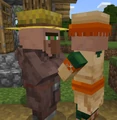Villagers are passive mobs that inhabit villages, work at their professions, breed, and interact. Their outfit varies according to their occupation and biome. A player can trade with villagers using emeralds as currency.
Spawning
Natural generation
Villagers can be found in villages, which spawn in several biomes such as plains, snowy tundras, savannas, deserts, taigas, and snowy taigas. A cleric villager and cleric zombie villager spawn locked up in the basements of igloos (if the basement generates) under the carpet of the floor. In Bedrock Edition, the villager and zombie villager inside igloo basements have random professions instead of always being clerics. The cleric villager can also turn into a leatherworker villager since the cauldron in the basement is closer to the villager.
Curing
When a zombie villager is cured, it transforms into a villager. The villager retains the profession it had as a zombie, if it had one before turning into a zombie villager. If the zombie villager is player spawned, it adopts a randomly chosen profession[Bedrock Edition only], since all zombie villagers are unemployed in Bedrock Edition. The villager can also be a nitwit, as the game counts it as a "profession" but the nitwit villager still can't work. If employed, such as in Java Edition, where the zombie villagers have a profession, the cured villager offers discounts on each of its trades, but to get the maximum discount you can zombify and cure them multiple times. Doing this can cause the villager to trade most of their items for only 1 emerald, but in Java Edition, attacking the villager causes it to progressively reduce the discount, just like the player loses popularity.
Spawning regularly
A village can also spawn villagers regularly if there are at least 20 villagers and 10 beds. {Needs game testing} The village can be an expanded village that is naturally generated, or a player built village. An easy way of expanding the village is breeding villagers, or you can cure a few zombie villagers you find around the village. Beds can be crafted like normal.
Variants
Zombie villagers
When a zombie kills a villager, it can turn the villager into a zombie villager, depending on the difficulty: 0% chance on easy, 50% chance on normal and 100% chance on hard. Zombie villagers also spawn naturally in the Overworld in the same conditions as a normal zombie, although much less commonly, with a 5% chance. Zombie villagers also spawn in abandoned villages and igloos.
Illagers

A vindicator chasing a villager.
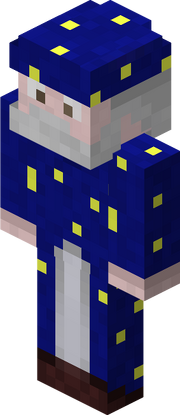
An illusioner attacking villagers.
Illagers are hostile villager-like mobs that spawn in woodland mansions as well as pillager outposts, illager patrols, or raids. The varieties of illagers are vindicators, evokers, pillagers, and illusioners[Java Edition only] (which can be summoned only by using commands), along with two associated mobs: vexes and ravagers. The ravager is considered a illager in Bedrock Edition, but not in Java Edition. Illagers are considered to be outcasts from villages, meaning they were once villagers, but turned evil, so they villagers kicked them out forever, leaving them the hatred of villagers[1]. In addition to attacking players, they also attack villagers, wandering traders, and iron golems. They do not go seeking for villagers, and never naturally come to villages, except during raids and patrols. In Bedrock Edition, sometimes a pillager outpost can generate on the border of a village, leading to altercations if any villager goes near the outpost.
In Bedrock Edition, illagers attack snow golems but do not attack baby villagers, although baby villagers still flee from them. "Johnny" vindicators still attack baby villagers.
Witches
Witches are hostile villager-like mobs that spawn anywhere in the Overworld in light levels of 7 or less, in swamp huts, as part of raids, or when a villager gets struck by lightning. Once a villager becomes a witch it cannot be turned back to a villager. Witches attack by throwing splash potions of harming, slowness, weakness and poison. They also use beneficial potions on themselves, especially healing potions when damaged, fire resistance potions if on fire, and water breathing potions if submerged in water. Witches in raids heal and buff illagers and other raider mobs by throwing beneficial potions and healing potions on them in Java Edition. Despite being allies with and looking similar in appearance to illagers, witches themselves are not considered illagers, are passive toward villagers and wandering traders, and are neutral toward iron golems in Java Edition. If a witch's negative splash potion hits a illager, the illager retaliates, leading to a fight.
Wandering trader
Wandering traders are a type of villager that spawn randomly close to the player in both editions, or periodically in village gathering sites in Bedrock Edition. Two trader llamas spawn leashed to the wandering trader. Players may use emeralds to buy items from wandering traders, but cannot trade items for emeralds. They also lock trades like villagers, but never unlock the trade. Like villagers, wandering traders are attacked by most zombie variants (though they do not have a zombified form, they die if a zombie kills it), illagers, ravagers[Java Edition only], and vexes. Wandering traders also drink a Potion of Invisibility at night (or when they see a hostile mob such as a illager or zombie). In Java Edition, they drink a milk bucket in the morning to remove the Invisibility. They despawn after 40-60 minutes (even with a name tag or in a minecart or boat). Wandering traders also spawn near bells.
Old villagers
An picture of all types of old villagers in Minecraft. From left to right: priest (purple robes), librarian (white robes), farmer (brown robes), butcher (white apron), blacksmith (black apron), and nitwit (green robes and facing backwards).
Old villagers are not used in Minecraft 1.14 and above. In Bedrock Edition, villagers that are in a world created before the Village & Pillage update looks like a old villager. In Java Edition, villagers in any world templates gets updated into the new villager.
NPC
NPCs are villager-like mobs in Minecraft Education and in Bedrock Edition. NPCs can behave almost like players. They can also chat to players and turn their heads. They are the only companions to chat with in a single player game. but can't move. NPCs cannot be pushed, but are affected by gravity. Breaking a block under a NPC causes it to fall like an armor stand. Using a bubble column on a NPC makes it go up.
Drops
A villager, either adult or baby, does not ordinarily drop any items or experience when killed. However, when a player holds an emerald or other item a villager is willing to trade for, the item it offers in trade appears in its hands. Killing the villager at such a time causes it to drop the item it was holding.
Upon successful trading, a villager drops 3–6.
Upon successful trading, while willing to breed, 8–11 is dropped.
Behavior
Movement patterns
Nitwit and unemployed villagers leave their homes at day and begin to explore the village. Generally, they wander inside the village during the day. They may go indoors or outdoors, periodically making mumbling sounds. Occasionally, two villagers may stop and turn to look at each other, in a behavior called socializing, during which they stare at another villager for 4–5 seconds at a time. They continuously stare at a nearby player unless the villager is trying to get into a house at night, farm food, work, or flee from a zombie or illager. Baby villagers may jump on beds and play tag with each other, similarly to how baby piglins and baby hoglins play tag.
In Bedrock Edition, baby villagers do not stop continuously in front of players, though they still do stare as they move.
Villagers tend to not travel far from their beds in a large village unless the job site or the nearest gossip site (bell) is far from their beds.
Villagers, like other mobs, can find paths around obstructions, avoid walking off cliffs of heights greater than 3 blocks, and avoid some blocks that cause harm. However, in crowded situations, one villager can push another off a cliff or into harm's way.
Villagers emit green particles if they join a village, set a bed or acquire a job site/profession.
Villagers run inside at night or during rain, closing doors behind them. They attempt to sleep at night, but if they cannot claim a bed, they stay indoors until morning. In the morning, they head outside and resume normal behavior. However, some villagers stay outside later than others unless being chased by an illager or zombie.
Villagers flee from zombies, zombie villagers, husks, drowned, zombified piglins [Bedrock Edition only], zoglins, vindicators, pillagers (even if their crossbow has been broken), ravagers, and vexes within 8 blocks, and evokers and illusioners within 12 blocks. Like other passive mobs, villagers sprint away when attacked.
If a villager finds itself outside the village boundary, or a villager without a village detects a village boundary within 32 blocks, it moves quickly back within the boundary. A villager taken more than 32 blocks away from its village boundary forgets the village within about 6 seconds. Whether in a village or not, a villager is never prone to despawning.
Villagers can open all wooden doors and find paths or blocks of interest behind the doors. However, they cannot open trapdoors, fence gates, or iron doors. Villagers can climb ladders, but do not recognize them as paths and do not deliberately use them. Any climbing of ladders seems to be a side effect of them being pushed into the block by another mob, (likely, and most often, other villagers). Unfortunately, this behavior can leave them stranded on the second floors and roofs of some structures, as they lack the necessary AI to descend ladders.[verify] A simple fix for these situations is for the player to manually push the villager back toward the ladder hole and then install a wooden trap door at the top, after the villager is returned to the ground level. One way to prevent a villager from climbing ladders is to break the first ladder touching the ground thus requiring a player to jump to the ladder to climb.
Preferred path
Villagers favor pathways to reach a selected destination and try to stay in low cost blocks, like the grass path or cobblestone blocks. They also avoid jumping.
| Preferred path blocks | Block cost | |
|---|---|---|
| Adult Villager | Baby Villager | |
| Grass Path | 0 | 0 |
| Cobblestone Stone |
1 | 1 |
| Beds Lectern |
50 | 50 |
| other | 3 | 1.5 |
| Jump cost | 20 | 5 |
Job site blocks
Villagers who have already claimed beds[Bedrock Edition only] (other than babies and nitwits) seek employment by searching a 48-block horizontal radius[verify] for a job site block. An unemployed villager acquires a profession and a job by claiming the first unclaimed job site block it can detect in that area. A job site block can be detected as long as it is in range, not already claimed, and the villager can pathfind to the block to claim it. This means if they cannot see or get to the block, they cannot claim it.[Java Edition only]
When the block is claimed, its owner emits green particles and no other villager can claim it unless the owner relinquishes it.
If a job site block is broken or destroyed, its owner (if any) emits anger particles[Bedrock Edition only] and becomes jobless, but retains its profession after trading. A villager who already has a profession but no job site attempts to find one:
- A villager who has not yet traded can claim any job site block and changes its profession along with acquiring a new job.
- Villagers who have made their first trade can claim a job site block only if the block is associated with their profession.
- For a villager to claim a job site block in Java Edition, the block must be on the ground to allow the villager to pathfind to the job block. A job site block placed decoratively on scaffolding or a fence post, for example, cannot be found by a villager and no job assignment results.
In Java Edition, villagers can change professions only while awake.
Gossiping
Spreading gossip informs other villagers of the reputation of players. Villagers acquire pieces of gossip through various means, and spread them to other villagers when they converse. There are five types of gossip: major_negative, minor_negative, major_positive, minor_positive, and trading. major_positive cannot be shared.
A villager generates minor_negative gossip if it is attacked by a player, major_negative gossip if it is killed by a player (which is immediately shared with all other nearby villagers), major_positive, and minor_positive gossip if it is cured by a player, and trading gossip if a player traded with the villager. In Java Edition, negative reputation causes villagers to temporarily increase their prices for the player in question, while a positive reputation results in lower prices. Overall reputation also determines the hostility of the village iron golem toward the player. The village's iron golem becomes hostile toward a player if the value of major_negative is 20 or higher. Attacking pandas make the villager angry at the player, but does not cause gossiping[verify].
An exact function to calculate the price affected by the gossips is the following:y = x - floor((5a + b + c - d - 5e) × p ). Where y is the final price, x is the base price, a is the value of major_positive, b is the value of minor_positive, c is the value of trading, d is the value of minor_negative, e is the value of major_negative, and p is the value of PriceMultiplier.
Each piece of gossip has a type, a target, and strength or "value". The target is the player who caused the gossip. If a piece of gossip would be generated in or spread to a villager, but the villager already has a piece of gossip with the same type and target, the existing gossip's strength is increased instead. If the gossip has a high strength then villagers are more likely to share that gossip.
When a gossip is shared, it is received at a reduced value. The reduction varies by gossip type (−20 for trading, −5 for minor_negative &minor_positive and −10 for major_negative). Gossips also reduce in value every 20 minutes by various amounts (−2 for trading, −20 for minor_negative, −10 for major_negative and −1 for minor_positive; major_positive does not reduce). The max level of major_positive obtainable in survival for a single player is 100.
Players can set villagers on fire using flint and steel or lava without affecting reputation. However, using flint and steel to detonate TNT near villagers causes reputation to decrease because the TNT's damage is attributed to the player. Redstone-activated TNT does not have this effect.
Picking up items
Villagers have eight hidden inventory slots, which start empty whenever the villager is spawned. Villagers do not intentionally seek out items to pick up, but they do collect any bread, carrots, potatoes, wheat, wheat seeds, beetroot, beetroot seeds, and bone meal within range (bone meal can be picked up only by farmer villagers). These are the only items they can pick up, although the player may use the /replaceitem command to put an arbitrary item into a villager's inventory. If a player and a villager are in the pickup range of an item at the same time, the player always picks it up first. If several villagers are next to an item, the same one picks up the item every time. Consequently, in constrained space, the same villager picks up any item dropped. This behavior prevents villagers from sharing food in a one-block space.
As of 1.16.1 villagers can fill all 8 inventory slots with the same item.
When killed or converted to a zombie villager, any inventory item of the villager is lost, even when /gamerule keepInventory is set to true.
If /gamerule mobGriefing is false, Villagers cannot pick up items, and farmer villagers cannot plant or harvest crops.
Like other mobs, villagers have four slots for worn armor, separate from their inventory. An adjacent dispenser can equip armor, elytra, mob heads or carved pumpkins to a villager, but the armor is not rendered (except for carved pumpkins and mob heads). The equipment functions as normal; for example, a villager wearing an armor piece enchanted with Thorns can inflict Thorns damage to attackers, and a villager wearing Frost Walker boots is able to create frosted ice. If a villager is converted into a zombie villager, the armor it was wearing is dropped, though it may be able to pick it up and equip it again.
Sharing food
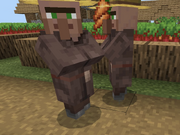
Villagers sharing carrots.
If a villager has enough food in one inventory stack (6 bread or 24 carrots, potatoes, beetroots, or 18 wheat for farmers only) and sees a villager without enough food in one inventory stack (3 bread, 12 carrots, 12 potatoes, or 12 beetroots for non-farmers; 15 bread, 60 carrots, potatoes, or beetroot, or 45 wheat for farmers), the villager may decide to share food with that villager.
To share, a villager finds its first inventory stack with at least 4 bread, carrots, potatoes, or beetroot or with at least 6 wheat, and then throws half the stack (rounded down) in the direction of the target villager. When wheat is shared, it is first crafted to bread, which may result in 1 or 2 less than half the stack being shared.
Farming
Farmer villagers tend crops within the village boundary. Villagers far enough outside the boundary of any village also tend nearby crops.
Farmland to be tended is found by seeking for certain blocks up to 9 blocks away from the villager in the X and Z coordinates and up to 1 away in the Y coordinate (a 19×19×3 volume total).
- If a farmer villager does not have enough food in one stack in its inventory (15 bread, 60 carrots, 60 potatoes, 60 beetroots, or 45 wheat) and finds fully-grown wheat, carrots, potatoes, or beetroot, the villager moves to the crop block and harvests it.
- If a farmer villager has any seeds, carrots, potatoes, or beetroot seeds in his inventory and finds an air block above farmland, the villager moves to it and plants a crop. They always plant from the first eligible slot in their inventory.
- If
/gamerule mobGriefingisfalse[Java Edition only], villagers cannot farm.
Breeding
Adult villagers breed depending on the time of the day and need to be willing to spawn § Baby villagers, who also require beds. Job sites are not required for villagers to breed.
The breeding depends on the number of valid beds. If a villager is "willing" (see § Willingness below), villagers breed as long as there are unclaimed beds available within the limits of the village. All baby villagers are initially unemployed.
A census is periodically taken to determine the current population of the village. All villagers within the horizontal boundary of the village and 5 vertical blocks[Java Edition only] of the center are counted as part of the population to determine if continued villager mating is allowed. However, any villager within the horizontal boundary of the village and the spherical boundary of the village attempts to enter mating mode as long as there is at least one villager within the boundary. If two villagers simultaneously enter mating mode while they are close to one another, they breed and produce a child. The appearance is determined by the biome where the breeding occurs in Bedrock Edition.[2] In Java Edition, the appearance is randomly determined by either the biome type of the parents or by the biome where the breeding occurred.
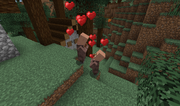
Two villagers breeding.
Willingness
Villagers must be willing to breed. Willingness is determined by the amount of food items a villager has. Becoming willing consumes the villager's food stock, therefore, after mating, villagers cease to be willing until they gather a sufficient stock of food items and breed again.
Villagers must have enough beds within village bounds for baby villagers to spawn. The beds must have 2 blocks of clearance above them because there needs to be room for the baby villager to jump on them. This means that the baby villager needs to be able to path-find the bed; it can't be in an unreachable spot. (Note that mobs view slabs as full blocks for pathfinding, so putting upper half slabs above a bed invalidates the bed.)
Villagers can become willing by having either 3 bread, 12 carrots, 12 potatoes, or 12 beetroots in one slot in their inventory. Any villager with an excess of food (usually farmers) throws food to other villagers, allowing them to pick it up and obtain enough food to become willing. The player can also throw bread, carrots, beetroots, or potatoes at the villagers themselves to encourage breeding. Villagers consume the required food upon becoming willing. If /gamerule mobGriefing is false, villagers don't pick up food.
Baby villagers
Baby villagers sprint around, entering and leaving houses at will. They sometimes stop sprinting to stare at an iron golem. If the iron golem is holding out a poppy, the children may cautiously take the flower from its hands. This is a reference to the 1986 Japanese animated movie, Laputa: Castle In The Sky, where a giant robot covered in vines (inspiration for the iron golem) gives the main characters flowers to put on a memorial.[citation needed] Baby villagers tend to group and chase one another around the village as if playing tag. They also jump on beds.
In Bedrock Edition, illagers ignore baby villagers until they reach adulthood.
Baby villagers give gifts of poppies or seeds to players who have the Hero of the Village effect in Java Edition.
Baby villagers in Bedrock Edition and Minecraft Education have a slightly bigger head than in Java Edition; this also can be seen in other baby mobs in the game as well.
A baby villager becomes an adult 20 minutes after birth.
Lightning
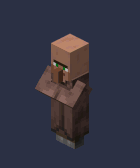
A villager gets struck by lightning.
When lightning strikes within 3–4 blocks of a villager, the villager is replaced by a witch who can't despawn.
Iron golem summoning
Villagers can summon iron golems. A villager desires a golem if the villager has gone to bed in the past 20 minutes and has not detected a golem in the past 30 seconds.[3] A villager scans for golems once every 10 seconds, and detects one if the golem's collision box is inside a 32x32x32 block box centred on the villager (obstructions do not matter). A villager that desires an iron golem and has 4 more desirous villagers "in range" attempts to summon one after it successfully spreads gossip (villagers spread gossip at most once every 60 seconds). Alternatively, a villager attempts to summon a golem every 5 seconds on a global timer if they are panicking (see below), desires one, and has 2 more desirous villagers "in range". 'In range' refers to being within a 20x20x20 block cube centred on the villager. If golem summoning is successful, the villager and all villagers within a 32x32x32 block cube have their 30 seconds "seen golem timer" reset.
Villagers can summon iron golems regardless of their profession (including nitwits) or latest working time[Java Edition only].
Panicking
In Java Edition, villagers panic if they see a mob that is hostile toward villagers, like a zombie, zombie villager, husk, drowned, zoglin, illager, vex, wither, or ravager and flee frantically from them, sometimes hiding in houses. In Bedrock Edition, villagers panic by running around in circles around a bed in a village house. Java Edition villagers in panic are more likely to summon iron golems. To see these mobs, the villager must have an unobstructed line of sight to it (eye-level to eye-level), and be within a certain range[3] (spherical distance between feet center bottom-most point of the villager and hostile mob): [verify]
| Mob | Panic radius |
|---|---|
| Zombie, Husk, Drowned, Zombie Villager, Vex | 8 |
| Vindicator, Zoglin | 10 |
| Evoker, Illusioner, Ravager | 12 |
| Pillager | 15 |
Zombies
Zombies, zombie villagers, husks, and drowned seek out and attack villagers within a 42-block radius[Java Edition only] or a 16-block radius[Bedrock Edition only] (even when the villager is invisible). Zombies attempt to break down doors, but only a fraction of zombies can do so and can succeed only when difficulty is set to hard. Zombies who cannot break doors tend to crowd around a door that separates them from a villager. If a zombie or a drowned comes across a set of doors with one open, it usually tries to go through the closed door.
Both zombies and drowned either kill villagers or convert them to zombie villagers. The chance of the villager becoming a zombie villager upon death is 0% on Easy, 50% on Normal, and 100% on Hard. Baby villagers can be infected by zombies as well. Drowned are able to convert villagers to zombie villagers, even when attacking with a trident from a distance.
Raids
During a raid, villagers flee from illagers and run to the nearest house, similar to a zombie siege. For a villager to hide, the house must have a door and at least one bed.
Before the first raid wave in Java Edition, at least one villager rushes to ring the bell in the center of the village (if they are close enough) to warn the other villagers of an incoming raid before going into their house. In Bedrock Edition, the bell rings automatically regardless of whether a villager is nearby. In Java Edition, when a bell is rung, all illagers within 48 blocks get the glowing effect for 3 seconds.
A villager often stays in the house it first entered, but may exit the house occasionally. The player can still trade with villagers during a raid.
On random occasions, the villager displays water particles as if sweating.
In Java Edition, once the player gains the Hero of the Village status after defeating a raid, villagers give them a discount for their trades and throw them gifts related to their profession. For a list of items that they can gift, see Hero of the Village § Gifts.
Staring

A lot of villagers staring at the player.
Villagers stare at any player that stares at them, or goes near them. This also applies for some mobs. A villager first turns it's head towards the player, then the body. Villagers can keep staring at the player unless a raid happens or a zombie comes and chases them off.
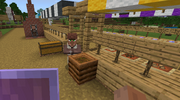
A villager staring at the player.
Schedules
Villagers have set schedules depending on their age and employment status. Schedules define the villager's goals, which mostly determine how they behave throughout the day. However, their goals can be interrupted by higher priority behaviors most villagers have, such as fleeing from an attack, trading, and getting out of the rain.
| Ticks (time) | Employed | Unemployed | Child | Nitwit |
|---|---|---|---|---|
| 00000 (06:00:00) | Work | Wander | Play | Sleep |
| 02000 (08:00:00) | Wander | |||
| 08000 (14:00:00) | Gather | |||
| 10000 (16:00:00) | Work | Wander | ||
| 11000 (17:00:00) | Home | |||
| 12000 (18:00:00) | Sleep | |||
| 13000 (19:00:00) | Home | |||
| 14000 (20:00:00) | Sleep | |||
| Ticks (time) | Employed | Unemployed | Child | Nitwit |
|---|---|---|---|---|
| 00010 (06:00:36) | Wander | Wander | Sleep | |
| 02000 (08:00:00) | Work | Wander | ||
| 03000 (09:00:00) | Play | |||
| 05000 (11:00:00) | Wander | |||
| 06000 (12:00:00) | Wander | |||
| 09000 (15:00:00) | Gather | |||
| 10000 (16:00:00) | Play | |||
| 11000 (17:00:00) | Wander | Sleep | ||
| 12000 (18:00:00) | Sleep | |||
Working
Employed villagers spend most of their day standing next to their job site blocks. From time to time they "gather supplies" by wandering a short distance away, then returning.
Some professions have additional job-specific goals that are part of their work schedule:
- Farmers harvest and sow crops.
- Librarians inspect bookshelves.[Bedrock Edition only]
When a villager reaches its job site block, it commences "work". Two times a day, this action of working resupplies any locked trades. Villagers can resupply twice per day, even without having a bed or while sitting in a minecart. A villager can "reach" its job site block if the block is in any of the 8 directly adjacent or diagonal block spaces horizontally around it at the height of their feet, or at the 9 blocks below that. Villagers can still "reach" them diagonally, even if they can't see or touch the face of the block.
Employed villagers do not breed with each other during their work schedule. Nitwits and the unemployed do not follow this rule as they would breed with each other and the employed villagers.
Wandering
All villagers wander from time to time, but for the unemployed, wandering is their main goal because it maximizes their ability to find a job site block they can claim (thereby becoming employed). Nitwit villagers wander for their whole day before returning home, and sometimes they even hang out with other employed villagers. A wandering villager chooses a random block and walks toward it, then stands there for a variable amount of time before wandering again. If at any time it detects a job site block it can claim, it does so, assumes the skin for the associated profession, and immediately begins following the appropriate schedule.
A villager attempts to claim a job site block by finding a path to a block next to one, showing angry particles when unable to reach it. After a villager fails to reach the job site block several times, it becomes unclaimed, indicated by showing angry particles on it. The villager loses its job site block and eventually becomes unemployed if the villager is at novice-level and no nearby job site block is available. Any other nearby unemployed villager has a chance to become the block's new owner. If there are no unemployed villagers nearby, then the villager who lost the job site block seeks for another unclaimed one or tries to reclaim the same unreachable one in an endless loop (this also happens for claiming beds).
The wander schedule includes a job-specific goal called "exploring the outskirts" that causes villagers to wander near the edges of the village. This enables them to detect new beds, job site blocks, bells, and houses that players have used to extend the village.
During this time of the day, they may also share items.
Gathering
Late in the day, adult villagers (other than nitwits) gather at a meeting place (the area around a bell). When two villagers encounter one another, they mingle (look at each other and "converse" by humming at other villagers). They may also share food, or breed if both are willing.
If a villager isn't close enough to detect a bell, it wanders randomly, searching for one.
Playing
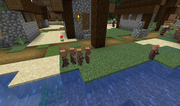
4 villager children chasing one another.
Baby villagers wander randomly searching for others to play with. When they find one, the two of them follow each other for a while and sometimes run as if racing or chasing each other.
Baby villagers wander randomly searching for beds to jump on.
They sometimes stop to stare at an iron golem. If the iron golem holds out a poppy, the baby villager cautiously accepts it [Java Edition only].
In Bedrock Edition, iron golems ignore all villagers and walk as though the villager is not there, kind of like pushing the villager.
Returning home
All villagers except nitwits head home a short time before sunset and nitwits go home after sunset. They roam around until they get near their beds, then target a block beside the bed. Once they reach their beds, they do not go through a door again before sleeping.
A villager who has no bed simply waits inside a house until morning. This includes players stealing a villager's bed to sleep in, mostly the villager stays in the house and doesn't move until sunrise. But sometimes, if they detect a unclaimed bed nearby they walk out of the house and towards the bed.
Sleeping

A villager sleeping in a bed at night (from the top view).
At sunset, most villagers lie down in their beds and remain there until morning (Nitwits stay up later at night and get up later in the morning). Villagers wake early if food is thrown at them [Java Edition only], they are pushed out of bed, or if their bed is destroyed. They also wake up when their bed is used, if they are attacked, or when a bell is rung. If possible, they return to sleeping in a bed after the interruption.
Jumping on a bed with a villager sleeping in it doesn't cause the villager to get up.
If an anvil is dropped on a villager while the villager is sleeping, the villager doesn't wake up.
A villager who has no bed continues wandering in search of a bed to claim.
Villagers can sleep in the Nether or The End, without causing the usual consequences (See Bed), if the Overworld's time is correct.
Sometimes when a villager gets in a bed from another direction they turn their body until their head is on the pillow of the bed. Villagers also sleep with their eyes open, just like players.
Healing
Villagers get a brief regeneration effect once leveling up in their profession.
In Bedrock Edition, when villagers successfully sleep, they immediately heal themselves when waking up at dawn if they are damaged.
Professions

All plains biome variant professions (except unemployed) corresponding to their different job site blocks.
Each villager can have a profession, indicated by their clothing as well as by the title at the top of the trading interface. A villager can choose their profession by claiming a job site block. When they go to work, they use their daily schedule to get to their claimed job site block. Some professions, like farmers and librarians, do other things. Farmers plant crops, and librarians can inspect bookshelves.
A job site block can be claimed only if it is unclaimed and within a village boundary with at least 1 bed. Removal of a claimed job site block causes the owner to switch to another profession or become unemployed, provided that the villager has no prior trades with the player. If the villager has prior trades, it keeps its profession and claims a new job site block that matches its profession if one is available. So, once a player trades with a villager, the villager keeps its profession forever.
Nitwits and baby villagers cannot change their profession.
Novice-level villagers who have not yet traded can lose their profession and change into unemployed villagers.
Unemployed adults actively seek for an unclaimed job site block and change into the corresponding profession.
Below is a table listing the various professions, along with the specific job site block that each profession requires:
Profession |
Job site block |
Biome | ||||||
|---|---|---|---|---|---|---|---|---|
| Desert | Jungle [4] |
Plains | Savanna | Snow | Swamp[4] | Taiga | ||
| Unemployed | None | |||||||
| Nitwit | None | |||||||
| Armorer | Blast Furnace | |||||||
| Butcher | Smoker | |||||||
| Cartographer | Cartography Table | |||||||
| Cleric | Brewing Stand | |||||||
| Farmer | Composter | 
|

|

|

|

|

|

|
| Fisherman | Barrel | |||||||
| Fletcher | Fletching Table | |||||||
| Leatherworker | Cauldron | |||||||
| Librarian | Lectern | |||||||
| Stone Mason[BE only] | Stonecutter | |||||||
| Shepherd | Loom | |||||||
| Toolsmith | Smithing Table | |||||||
| Weaponsmith | Grindstone | |||||||
Nitwit
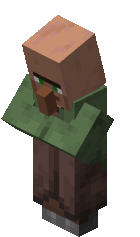
A nitwit shaking its head
Nitwit villagers wear robes that are green on top. They cannot acquire a profession, trade, or gather around bells, but are still able to breed. They are not equipped with a level stone since they cannot trade. Pressing use on a nitwit in Java Edition causes it to grunt and shake its head at the player. They wander around the village for about 2000 ticks after other villagers go to sleep, before seeking a bed. If they can claim a bed, they arise in the morning 2000 ticks after the rest of the village wakes up. A nitwit must be born or spawned; no villagers change to nitwit from unemployed or a profession, and vice versa. Nitwits can be found naturally or by curing naturally spawned zombie villagers. Zombie villagers can also be spawned as babies, so this is the only way to encounter baby nitwits in survival mode. In Bedrock Edition, every baby villager has a 10% chance to become a nitwit when they become an adult.
Appearance
Villagers and zombie villagers have seven skin types corresponding to the biome they spawn in. Their appearance also varies based on their profession and their five tiers. They show which trade tier they have unlocked by a badge of a varying material on their belt. A new tier is obtained every time a player trades with a villager and the badge appears as stone, iron, gold, emerald, and finally diamond.
Villagers have different outfits depending on their biome. Naturally generated villagers take on the outfit from the biome they were spawned in. When breeding occurs, the outfit of the child is determined by the biome where the breeding occurs, but in Java Edition, it is sometimes randomly inherited from the biome type of the parents. The outfits available are:
- Desert outfit: desert and badlands biome and variants
- Savanna outfit: savanna biome and variants
- Taiga outfit: taiga, giant tree taiga, taiga mountains, and mountains biome and variants
- Snowy outfit: any snowy biomes (including snowy taiga, frozen river, frozen ocean (and its variants) and snowy beach)
- Swamp outfit: swamp biome and variants
- Jungle outfit: jungle biome variants (including bamboo jungle)
- Plains outfit: plains and all other biomes not listed above, including mushroom fields and variants, beaches, and ocean biomes. Villagers spawned in the nether or the end also have the plains biome outfit.
Villagers have 15 professions:
- Farmer (straw hat)
- Trades crops and natural foods.
- Fisherman (fisher hat)
- Trades campfires and fishing items.
- Shepherd (brown hat with white apron)
- Trades shears, wool, dyes, paintings and beds.
- Fletcher (hat with feather and quiver on the back)
- Trades bows, crossbows, all types of arrows (except luck) and archery ingredients.
- Cleric (purple apron and creeper cloak)
- Trades magic items like ender pearls, redstone dust, and enchanting or potion ingredients.
- Weaponsmith (eyepatch and black apron)
- Trades minerals, bells and enchanted melee weapons. The axe enchantments are weapon related.
- Armorer (welding mask)
- Trades foundry items and sells chain, iron and enchanted diamond armor tiers.
- Toolsmith (black apron)
- Trades minerals, bells and harvest tools. The tool enchantments are axe related.
- Librarian (eyeglasses and a book as a hat)
- Trades enchanted books, clocks, compasses, name tags, glass, ink sacs, lanterns, and book and quills.
- Cartographer (golden monocle)
- Trades banners, compasses, banner patterns, papers and various maps, including explorer maps.
- Leatherworker (brown apron and brown gloves)
- Trades scutes, rabbit hide, and leather-related items.
- Butcher (red headband and white apron)
- Trades meats, sweet berries, rabbit stew, and dried kelp blocks.
- Mason[JE only]/Stone Mason[BE only] (black apron and black gloves)
- Trades polished stones, terracotta, clay, glazed terracotta and quartz.
- Nitwit (green coated, no badge)
- No trades
- Unemployed (no overlay, base clothing of biome without extra feature)
- No trades until employed. No badge until employed.
Trading
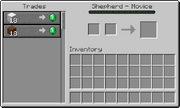
The Java Edition trading interface displaying two available trades.

Villager badge changes color depending on the level of the villager. From left to right: stone (novice), iron (apprentice), gold (journeyman), emerald (expert), and diamond (master). Nitwits, unemployed adults, and children do not have a badge.
The trading system is a gameplay mechanic that allows players to buy and sell various items to and from villagers, using emeralds as a currency. Their trades can be valuable or somewhat meaningless, depending on the cost, the items the player might get, and how the player treats the villagers. Only adult villagers with professions can trade; the player cannot trade with nitwits, unemployed villagers, or baby villagers. Attempting to do so causes the villager to display a head-shaking animation and play the villager's declined trade sound[Java Edition only].
Using an employed villager allows a player to trade, making offers based on the villager's profession and profession level. All offers involve emeralds as a currency, and items related to the villager's profession. Trading can allow the acquisition of items that would otherwise be difficult or impossible to obtain, such as enchanted books with "treasure" enchantments (e.g. Mending), bottles o' enchanting, or chainmail armor. When a villager gets a new trade, they receive 10 seconds of Regeneration I (totaling to 4![]()
![]() of restoration), which emits pink particles. The villager also emits green particles suggesting contentment.
of restoration), which emits pink particles. The villager also emits green particles suggesting contentment.
Completing a trade with a villager increases its professional-level slightly. Some trades grant higher levels to the villager, while others do not. As it advances through its profession, the villager offers additional trades. When a villager unlocks a new trade at a higher level, it almost always grants more experience than every lower-level trade.
Villagers have a maximum supply of items and after the player has traded for an item that many times, the villager's supply of the item is exhausted. This results in the trade being temporarily locked. A player can continue to trade for the villager's other available items if any. Exhausted items are restocked when the villager works at a job site, up to twice per day.
Clicking use on a unemployed villager or a nitwit villager causes it to grunt and shake their head. {Java Edition only} In Bedrock Edition, clicking use on a unemployed villager or a nitwit villager does nothing.
Supply and demand
The price of an item can rise and fall with changes in demand. The price of a traded item can rise when next resupplied, or fall from a risen price if not traded. Demand is stored per item, not per villager.
Trade offering
Several villagers offering trade items to a player.
When a player holds an item near a villager who wants that item, the villager holds up an item it offers in exchange. For example, a villager who buys 20 wheat for one emerald holds up an emerald, offering it to a player holding wheat. Villagers do not offer trades that are currently out of stock. If the villager has more than one trade for an item, it cycles through the trades, offering a different item every few seconds. This kind of trading interaction makes it easier to find villagers who offer a particular trade, but the player must still open the trading interface to complete the trade. Note that villagers do not hold items to offer trades during their gather or sleep phases, even though it is still possible to trade with them.
Economic trade
Villagers have levels and require experience to unlock the next tiers of trade; level 1 is a novice, level 2 is apprentice, level 3 is journeyman, level 4 is expert, and level 5 is master. Villagers can resupply trades by themselves by working more at their job site block.
Popularity
In Java Edition, villagers increase their prices of trades if a player's popularity is low, (e.g. from damaging villagers), and decrease it if their popularity is high (e.g. from trading with multiple villagers). Curing a zombie villager in Bedrock Edition or defeating a raid in Java Edition also increases the player's popularity by 10.
Hero of the Village
When a player receives Hero of the Village, players receive discounted prices on all the items traded by villagers in both editions. The Hero of the Village also gets gifts.[Java Edition only] Each villager throws gifts related to its profession. These gifts range in value from common (like seeds) to rare items (like chainmail armor). A player's popularity increases by 10 in Java Edition and doesn't increase in Bedrock Edition. Villagers also shoot off fireworks.[Java Edition only]
Sounds
| Sound | Subtitles | Source | Description | Resource location | Translation key | Volume | Pitch | Attenuation distance |
|---|---|---|---|---|---|---|---|---|
| Villager mumbles | ? | Villager is talking | entity | subtitles | ? | ? | 16 | |
| Villager cheers | ? | Villager is happy | entity | subtitles | ? | ? | 16 | |
| Villager dies | ? | Villager dies/becomes zombified | entity | subtitles | ? | ? | 16 | |
| Villager hurts | ? | Villager gets hurt | entity | subtitles | ? | ? | 16 | |
| Villager disagrees | ? | Player trades with either an unemployed villager, a nitwit, or fails to trade with an employed villager due to lack of resources. | entity | subtitles | ? | ? | 16 | |
| Villager trades | ? | Player opens the trade UI on a villager | entity | subtitles | ? | ? | 16 | |
| Villager agrees | ? | Player successfully trades with the villager. | entity | subtitles | ? | ? | 16 | |
| Fletcher works | ? | ? | entity | ? | ? | ? | 16 | |
| Cleric works | ? | ? | entity | ? | ? | ? | 16 | |
| Farmer works | ? | Adding to a composter | entity | ? | 0.3 | 0.8 | 16 | |
| Armorer works | ? | ? | entity | ? | 1.0 | ? | 16 | |
| Toolsmith works | Blocks | ? | entity | ? | 1.0 | 1.0 | 16 | |
| Butcher works | ? | ? | entity | ? | ? | ? | 16 | |
| Fisherman works | Blocks | ? | entity | ? | 1.0 | 1.0 | 16 | |
| Weaponsmith works | ? | ? | entity | ? | ? | ? | 16 | |
| Leatherworker works | ? | ? | entity | ? | 1 = 0.9; 1, 2, 3 = ? | ? | 16 |
Data values
ID
| Name | Identifier | Translation key |
|---|---|---|
| Villager | villager | entity.minecraft.villager |
| Name | Identifier | Numeric ID | Translation key |
|---|---|---|---|
| Villager (old) | villager | 15 | entity.villager.name |
| Villager (new) | villager_v2 | 115 | entity.villager_v2.name |
Entity data
Villagers have entity data associated with them that contains various properties.
- Entity data
- Additional fields for mobs that can breed
- Tags common to all entities
- Tags common to all mobs
- Tags common to all villagers
- Inventory: Each compound tag in this list is an item in the villager's inventory, up to a maximum of 8 slots. Items in two or more slots that can be stacked together are automatically condensed into one slot. If there are more than 8 slots, the last slot is removed until the total is 8. If there are 9 slots but two previous slots can be condensed, the last slot returns after the two other slots are combined.
- An item in the inventory, excluding the Slot tag.
- Tags common to all items
- An item in the inventory, excluding the Slot tag.
- LastRestock: The last tick the villager went to their job site block to resupply their trades.
- LastGossipDecay: The last tick all gossip of the villager has decreased strength naturally.
- RestocksToday: The number of restocks a villager has done in 10 minutes from the last restock, or
0if the villager has not restocked in the last 10 minutes. When a villager has restocked twice in less than 10 minutes, it waits at least 10 minutes for another restock. - Willing: 1 or 0 (true/false) – true if the villager is willing to mate. Becomes true after certain trades (those that would cause offers to be refreshed), and false after mating.
Villager type
Villager profession
Achievements
| Icon | Achievement | In-game description | Actual requirements (if different) | Gamerscore earned | Trophy type (PS4) | |
|---|---|---|---|---|---|---|
| PS4 | Other | |||||
| The Haggler | Acquire or spend 30 Emeralds by trading with villagers or with wandering trader. [sic] | — | 30G | Silver | ||
| Treasure Hunter | Acquire a map from a cartographer villager, then enter the revealed structure | Visit the structure indicated while the purchased map is in your main hand (hotbar). | 40G | Silver | ||
| Buy Low, Sell High | Trade for the best possible price. | Buy something for 1 emerald, or when the Hero of the Village effect is applied. | 50G | Gold | ||
| Master Trader | Trade for 1,000 emeralds. | Obtain 1,000 emeralds from trading with villagers. | 30G | Silver | ||
Advancements
| Icon | Advancement | In-game description | Parent | Actual requirements (if different) | Resource location |
|---|---|---|---|---|---|
 | Adventure | Adventure, exploration and combat | — | Kill any entity, or be killed by any entity. | adventure/root
|
 | What a Deal! | Successfully trade with a Villager | Adventure | Take an item from a villager or wandering trader's trading output slot, and put it in your inventory. | adventure/trade
|
 | Very Very Frightening | Strike a Villager with lightning | A Throwaway Joke | Hit a villager with lightning created by a trident with the Channeling enchantment. | adventure/very_very_frightening
|
History
| Java Edition | |||||
|---|---|---|---|---|---|
| 1.0.0 | Beta 1.9 Prerelease | ||||
| Villagers share the same AI as pigs. | |||||
| Villagers have the name "TESTIFICATE" displayed over their heads as player names are displayed in multiplayer. | |||||
| Villages have 5 main professions (0, 1, 2, 3, 4), and other profession numbers were a green-robed unnamed villager. | |||||
| "We added them in 2011, but in the beginning they were completely useless - you couldn't trade with them, they didn't have any sound effects or anything. Their only purpose was to live in the villages. We discussed a lot about what they would do - we knew we wanted trading, but we weren't sure about what would happen with the village itself. Would the player do quests around the village? Would it expand?" – Jeb[5] | |||||
| Beta 1.9 Prerelease 2 | The "TESTIFICATE" name above villager's heads has been removed. | ||||
| 1.1 | 11w49a | Added the villager spawn egg to creative mode. However, only farmer villagers are spawned. | |||
| 1.2.1 | 12w05a | Villagers now go inside at night and detect houses. | |||
| 12w05b | Villagers can now open and close doors. | ||||
| ? | |||||
| 12w06a | Villagers can now socialize with each other and passive mobs. | ||||
| Villagers are now attacked by and run away from zombies. | |||||
| Villagers now go inside shelter whenever it rains. | |||||
| 12w07a | Villagers now repopulate villages by the number of houses there are. | ||||
| Villager children now sprint. | |||||
| 1.3.1 | 12w18a | Villagers spawned via a spawn egg now have a random profession. | |||
| 12w21a | Added trading with villagers. Leaving a trading window open cause villagers not to wander under normal circumstances. | ||||
| 12w22a | Villagers now reassign their profession if there is a lack of a specific profession or if the number of villagers in a profession is unbalanced (i.e., if there are many farmer villagers and no blacksmith villagers, one change its skin, showing it has changed its profession). | ||||
| Trading has also been changed, where an extra input space has been added where tools can be placed for buying enchantments and/or repair. | |||||
| 12w25a | Villagers may now remove a trade option after it has been used at least 3 times. | ||||
| 12w26a | Although requiring external tools or modifications to apply, spawners can now spawn the previously unavailable green robe villagers in unmodified Minecraft clients. | ||||
| 1.4.2 | 12w32a | Villagers now like and dislike the player, depending on how they react to them. | |||
| Villagers can now be infected by zombies, causing them to change their appearance and attack the player and other villagers. | |||||
| 1.4.4 | pre | Villager children can now be spawned easily by right-clicking a villager with a villager spawn egg. | |||
| 1.6.1 | 13w22a | Added sound effects for villagers. They have different sounds for taking damage, talking to villagers, successful trades, and canceled trades. | |||
| 1.8 | 14w02a | Added careers to villagers, splitting up the trade offers within a profession. This career is shown in the trading interface. | |||
| The trading system has been reworked to be less random; it is now tier-based instead, and several offers may be generated at one time. | |||||
| Due to the changes in the trading system, attempting to trade with generic villagers crashes the game. | |||||
| Villagers now breed only when willing. This limits the number of villagers and prevents infinite breeding villages. | |||||
| 14w02c | Villagers that had professions more than 4 now repeat in 0-4. | ||||
| Generic villagers can now be spawned only by using negative profession numbers. | |||||
| 14w03a | Villagers struck by lightning now turn into witches. | ||||
| 14w04a | Farmer (profession) villagers now harvest fully grown crops. | ||||
| Villagers can now be made willing using 3 bread, 12 carrots or 12 potatoes. | |||||
| 14w04b | Villagers now have an NBT tag that allows control over getting experience for trading (reward exp). | ||||
| 14w20a | The generic villager has been completely removed. However, the texture still exists in the Minecraft files. | ||||
| 1.8.1 | pre4 | Villagers no longer ignore data tags or damage values. | |||
| 1.9 | 15w31a | Farmer villagers now harvest beetroot crops, but ignore the drops. | |||
| 15w38a | Villagers now pick up beetroot and beetroot seeds. | ||||
| Villagers now use and share beetroot as food. | |||||
| Farmer villagers can now plant beetroot seeds. | |||||
| 15w39a | Villagers are now slightly taller (1.95 blocks tall rather than 1.8, with babies 0.975 blocks tall rather than 0.9). | ||||
| 15w43a | A priest villager can now be found caged in an igloo basement. | ||||
| 1.11 | 16w32b | ||||
The entity ID has been changed from Villager to villager | |||||
| 16w39a | Added a new career for the librarian villager called "Cartographer". | ||||
| 16w43a | Villagers are now able to draw from their own loot tables. | ||||
| 1.13 | 17w47a | The weapon smith's career ID has been changed from 3 to 2 and the Tool Smith's from 2 to 3. | |||
| 18w11a | Villagers now run away from drowned. | ||||
| September 29, 2018 | The Village and Pillage update, which improves villagers and villages, was announced at MINECON Earth 2018. | ||||
| 1.14 | 18w47a | Villagers now hide in houses during raids. | |||
| 18w50a | Added new mason profession. | ||||
| Villagers now have different skins based on biome (including swamps and jungles, which do not contain villages), as well as profession. | |||||
| Villagers now have five tiers and show which trade tier they've unlocked, by a badge of a varying material on their suit. The first trade tier appears as a stone badge, the next iron, then gold, emerald and finally diamond. | |||||
| Villagers now run away from and get infected by giants. | |||||
| 19w03a | Villagers no longer run away from nor get infected by giants. | ||||
| 19w11a | Added many new villager trades, for each villager profession. | ||||
| Villager trading prices now also depend on the player's popularity in the village. | |||||
| Villagers now resupply their trades up to two times a day, if they get to work at a job site block. | |||||
| The villager trading UI has been updated. | |||||
| Villagers now level up in a new way. | |||||
| Villagers now have a daily schedule. They go to work and meet up at the village bell. Each villager tries to find its own bed and job site block. Each profession has a specific block that works as a job site block for them (e.g. lectern for the librarian and cauldron for the leatherworker). | |||||
| Villagers now sleep in beds at night. | |||||
| Iron golems now spawn when enough villagers meet. | |||||
| 19w13a | Villagers can now trade during raids again. | ||||
| Villagers now sweat during raids. | |||||
| Villagers now hide in houses when a bell is rung by the player. | |||||
| Villagers now throw gifts to players with the different Hero of the Village status effects, with the gift item depending on their profession. Baby villagers throw poppies. | |||||
| 19w13b | The trading UI of villagers has been revamped. | ||||
| Available trades are now listed in a left sidebar, similar to Bedrock Edition. | |||||
| When players have the required materials, clicking on one of the trades now put the items into the slots automatically. | |||||
| 19w14a | |||||
| Pre-Release 1 | Fletcher villagers no longer sell luck arrows. | ||||
| 100% of villager trades are now discounted when the player has the Hero of the Village effect. | |||||
| 1.14.3 | pre1 | Panicking villagers now have a higher chance of spawning iron golems. | |||
| Farmer villagers now spend more time farming when they are working. | |||||
| Farmer villagers now always give away food even if other villagers do not need it. | |||||
| pre2 | Panicked villagers now have to work and sleep, so they cannot be in a state of panic all the time. | ||||
| The "last slept" and "last worked" properties for villagers are now saved properly. | |||||
| 1.14.4 | pre1 | Villagers now voluntarily pick up items. | |||
| pre2 | Villagers now stock more items, so they now can trade more items before they lock their trades. | ||||
| Villagers now remember their gossip after becoming a zombie villager. | |||||
| Gossip about players who converted a zombie villager now last longer. | |||||
| Villagers can now work without also restocking at the same time. | |||||
| The performance of villager pathfinding has been improved. | |||||
| 1.15 | 19w35a | Nitwit villagers no longer have a leveling gemstone in their belt. | |||
| If a player tries to sleep in a bed that is occupied by a villager, that villager is now kicked out of the bed. | |||||
| 1.16 | 20w19a | Villagers can now spawn iron golems regardless of their profession status or latest working time. | |||
| 20w22a | Villagers no longer try to work at the same workstation. | ||||
| When a workstation is placed, the most experienced nearby villager for that corresponding profession claims the workstation. | |||||
| Villagers now have to walk to and reach the workstation before they can acquire the profession/work there. | |||||
| Villagers can no longer claim workstations/professions during raids or night time. | |||||
| Villagers now check that their workstation is valid at all times of day as long as they are within 16 blocks of their workstation. | |||||
| 1.16.2 | 20w28a | Villagers now emit green particles when joining a village, setting a home bed, or acquiring a job site/profession to match Bedrock Edition. | |||
| Pre-release 1 | Villagers now lose their job sites when changing dimension. | ||||
| Upcoming Java Edition | |||||
| 1.17 | 21w11a | ||||
| 21w13a | Can now accept a filled cauldron as a valid workstation. | ||||
| Mason villagers can now sell 4 dripstone blocks for an emerald. | |||||
| Pocket Edition Alpha | |||||
| v0.9.0 | build 1 | ||||
| Villagers have the same level of AI as PC version 1.0.0, as they cannot trade, harvest crops, breed or open doors. | |||||
| build 2 | Villagers now have sounds. | ||||
| build 3 | Villagers are now attacked by and run away from zombies. | ||||
| Villager children now sprint. | |||||
| v0.9.2 | Villagers now have sounds on iOS and Fire OS. | ||||
| v0.10.0 | build 6 | The villager walking animation has been changed. | |||
| v0.12.1 | build 1 | Villagers can now open and close doors. | |||
| Villagers now go inside at night and detect houses. | |||||
| Villagers can now socialize with each other and passive mobs. | |||||
| Farmer villagers now harvest fully grown crops. | |||||
| Villagers now repopulate villages by the number of houses there are. | |||||
| Villager children now sprint. | |||||
| Villagers now like and dislike the player, depending on how they react to them. | |||||
| Villagers can now be infected by zombies, causing them to change their appearance and attack the player and other villagers. | |||||
| build 10 | Villagers now always become zombie villagers in Hard difficulty. | ||||
| v0.13.0 | build 2 | Villagers now open all wooden doors (rather than just oak). | |||
| v0.14.0 | build 1 | Villagers struck by lightning now transform into witches. | |||
| Villagers are now slightly taller (1.95 blocks tall rather than 1.8, with babies 0.975 blocks tall rather than 0.9). | |||||
| v0.15.0 | build 1 | Villagers now run away from husks. | |||
| Pocket Edition | |||||
| 1.0.0 | alpha 0.17.0.1 | Villagers now spawn in igloo basements. | |||
| 1.0.4 | alpha 1.0.4.0 | Added trading with villagers. | |||
| Villagers can now share food with other villagers. | |||||
| Villagers can now be made willing by using 3 bread, 12 carrots or 12 potatoes. | |||||
| Villagers now breed only when willing. | |||||
| 1.1.0 | alpha 1.1.0.0 | Villagers now run away from illagers and vexes. | |||
| alpha 1.1.0.3 | Added a new career for librarian villagers called "Cartographer". | ||||
| Bedrock Edition | |||||
| 1.4.0 | beta 1.2.13.8 | Villagers now run away from drowned. | |||
| 1.9.0 | beta 1.9.0.0 | Villagers now run away from pillagers. | |||
| 1.10.0 | beta 1.10.0.3 | Added nitwit and unemployed villagers. | |||
| Added mason profession, which can be traded with. | |||||
| Villagers now run away from the new ravager. | |||||
| Added a new type of villager. Both the old (pre-Village & Pillage) and new types of villagers are able to be spawned in-game and have different spawn eggs, although they have the same name and same spawn egg texture. | |||||
| Villagers now have different skins based on biome (including swamps and jungles, which do not contain villages) as well as professions. However, villagers spawned in igloo basements still use their old skin. | |||||
| Villagers now have three tiers and show which trade tier they have unlocked, by a badge of a varying material on their suit. The first trade tier appears as an iron badge, then next gold and finally diamond. | |||||
| Librarian villagers now inspect bookshelves. | |||||
| Villagers can now occupy beds to sleep. | |||||
| Villagers now have a schedule. Adult and child villagers have a different schedule and fishermen, farmers and librarians have special work schedules. | |||||
| Villagers now hold the item they want to trade. | |||||
| Villagers now have behavior to wander village outskirts. | |||||
| Villagers can now mingle in gathering sites. | |||||
| Villagers can now work in job sites with the corresponding job site block and can change professions depending on the available job site blocks in villages. | |||||
| 1.11.0 | beta 1.11.0.1 | The farmer job site block has been changed from farmland to composters. | |||
| Added economic trades, which makes villagers level up and require experience to unlock next tiers, which makes it possible to instantly change their tiers from iron to diamond. | |||||
Villager trades are no longer instantly refreshed as it now requires to resupply, which can be activated only by using /resupply. | |||||
Old villagers now convert to villager_v2 . | |||||
| Baby villagers are now ignored by illagers, including ravagers and vexes. | |||||
| beta 1.11.0.3 | Villager now heal themselves upon waking up at dawn. | ||||
| beta 1.11.0.4 | Villagers now hide in houses during raids. | ||||
| The villager economy trades have been changed. | |||||
| The supply and demand feature for villagers now works properly. | |||||
| Villagers now make sounds when they work. | |||||
| 1.13.0 | beta 1.13.0.9 | Villagers can now heal if they have bread in their inventory. | |||
| Upcoming Bedrock Edition | |||||
| 1.16.230 | beta 1.16.230.54 | Mason villagers can now sell 4 dripstone blocks for an emerald. | |||
| Legacy Console Edition | |||||
| TU7 | CU1 | 1.0 | Patch 1 | 1.0.1 | |
| Villagers have the same level of AI as PC version 1.0.0, as they cannot trade, harvest crops, breed or open doors. | |||||
| TU11 | The limit for villagers has been increased in a world. | ||||
| TU12 | Villagers can now open and close doors. | ||||
| Villagers now go inside at night and detect houses. | |||||
| Villagers can now socialize with each other and passive mobs. | |||||
| Villagers are now attacked by and run away from zombies. | |||||
| Villagers now repopulate villages by the number of houses there are. | |||||
| Baby villagers now sprint. | |||||
| TU13 | A limit to the number of villagers spawned by breeding has been added. | ||||
| Added the hearts display when villagers enter 'love mode'. | |||||
| TU14 | 1.04 | Trading with villagers has been added. | |||
| Villagers are now assigned random professions. | |||||
| Villagers that are spawned from a spawn egg now have a random profession. | |||||
| Villagers now make sounds from being hurt, trading and wandering. | |||||
| Baby villagers can now be spawned by using | |||||
| TU31 | CU19 | 1.22 | Patch 3 | Villagers now have additional professions and trading schemes. | |
| Villagers now harvest crops. | |||||
| Villagers now breed only when willing (and can be made willing by giving them 3 bread, 12 carrots or 12 potatoes). | |||||
| Villagers turn into witches when struck by lightning. | |||||
| TU54 | CU44 | 1.52 | Patch 24 | 1.0.4 | Added a new career for the librarian villager: "Cartographer". |
| 1.91 | Added nitwit, unemployed villagers. | ||||
| Added mason villagers, which can be traded with. | |||||
| Villagers have new clothing to indicate their level, profession, and biome. | |||||
| Villagers now have a schedule. Adult and child villagers have a different schedule. | |||||
| Villagers may now wander to the village outskirts. | |||||
| Villagers now attempt to find a door when it rains during the day and navigate to their bed at night. | |||||
| The pathfinding of villagers has been updated and improved. | |||||
| Villagers now have a visual-based trading system, and now hold up the item they wish to trade. | |||||
| Villagers now mingle together around gathering sites in the village. | |||||
| Librarian villagers now inspect bookshelves. | |||||
| Villagers can now switch professions depending on the job site blocks available in the village. | |||||
| Villagers now interact with beds and corresponding job site blocks. | |||||
| New Nintendo 3DS Edition | |||||
| 0.1.0 | |||||
| 1.9.19 | Added a new career for the librarian villager: "Cartographer". | ||||
An image released earlier by Jeb showing separated villagers.[6]
The new Jungle villager textures shown at MINECON Earth 2018.
New villager textures, shown at MINECON Earth 2018, announced as the Taiga biome variants. They are instead used for the Snowy Tundra biome variants.
Issues
Issues relating to "Villager" are maintained on the bug tracker. Report issues there.
Trivia
- The villagers were inspired by the shopkeepers in Dungeon Master 2.[7]
- Originally, the mobs populating villages were to be pigmen.[8]
- Name tags used on villagers always name the villager instead of opening the trading interface.
- Villagers, unlike illagers and zombie villagers, do not visually sit down when riding objects such as boats and minecarts, behavior which also applies to Witches and Wandering Traders.[9]
- After a zombie villager is cured, the villager gets Nausea for 10 seconds (indicated by the purple status effect particles).
- When a villager is in love mode, it walks slowly. However, when a villager runs indoors as the night falls, it runs faster than the player's sprinting speed.
- Villagers use their schedules if the village is in the Nether or the End. This is because the daylight cycle continues in these dimensions, even though it is not normally apparent to the player.
- Unlike players, villagers can claim and sleep in beds in the Nether and the End without causing them to explode.
- The new villager skins added in the Village and Pillage update were inspired by 2018 fashion shows, such as Gucci's.[10]
- Villagers occasionally sleep in odd ways during the night inside their beds, sometimes hanging halfway off the side of the bed or even glitching into walls.
- Similarly to librarians and farmers, fishermen have a custom schedule that allows them to have a job-specific goal. However, currently, none is defined.
- Although the villages in snowy taiga biomes spawn the snowy villager variant, they use the taiga village variant.[BE only]
- Although there are no jungle or swamp village variants, these villagers can spawn naturally if another village variant extends into a jungle or swamp.
- When the Programmer Art resource pack is enabled, all villagers have a green hood on their heads. This is because the Programmer Art nitwit texture (which had the hood in the texture since its addition) is called the same as the Village & Pillage base villager texture.[11]
- Baby villagers are the only mobs that do not have a disproportionately large head compared to their adult counterparts. Rather, they are smaller versions of the adult villager.[JE only]
- Farmer villagers use and pick up bone meal. They also fill their composter with seeds.
- Giving a villager any item (with commands) causes it to hold the item as if offering it, but it cannot be traded.
- Fisherman villagers have been intentionally textured by Jasper Boerstra to display the long-since-removed raw fish texture.[12]
- Villagers display their held items differently than most creatures do, using the "ground" parameter instead of the usual hand parameter in model display settings.
- Villagers (and baby villagers) on boats that have claimed a bed can still sleep when the bed is near to them resulting in them sleeping in the boat instead.[Bedrock Edition only]
- The Librarian professioned Villager appears to have a book on their head.
April fools
On April 1, 2014, Mojang announced that villagers have taken over the skin servers and content delivery networks (CDN) as an April Fools joke. This caused the player's current skin to turn into villager skins, and caused users to be unable to change their skins unless modifying the launcher .json file. Different career villager skins were used, including the then-unused nitwit villager (green robe).
Many of the sounds were also changed, supposedly by the villagers. They seem to be similar to a villager talking (with words, rather than their normal sounds). The in-game music has also been altered to include villager like noises, and also features a villager version of the "Game of Thrones" theme on the title screen. The sounds originate from the sound resource pack created by Element Animation, titled The Element Animation Villager Sound Resource Pack (T.E.A.V.S.R.P.), which is based on the villagers appearing in their fan videos. The villagers were voiced by Dan Lloyd, Director of Element Animation.
The skins and the sounds were reverted to the way they were before on April 2, 2014. However, this update cannot be activated by setting the computer's date to April 1, 2014.
Gallery
Screenshots
In Other Media
- Villagers mojang.png
Snowy villager artwork.
Villagers in promotional artwork for the Horse Update.
Villagers in promotional artwork for the World of Color Update.
A group of villagers shown in the Village and Pillage update artwork.
A Villager in promotional artwork for Education Edition 1.14.50.
Villager micromob (right) from Lego Minecraft.
References
- ↑ "MINECON 2016 The Minecraft 1.11 Change Log" – Minecraft on YouTube, October 15, 2016
- ↑ https://youtu.be/AnOeYZi4fgc&t=48m33s
- ↑ a b https://youtu.be/vMSiholH_lc
- ↑ a b Jungle and Swamp villagers can spawn only in their corresponding biome if a village intersects these biomes, or by using spawn eggs, breeding or curing a zombie villager, as jungle and swamp villages do not exist.
- ↑ "Meet the Villagers" by Marsh Davies. Minecraft.net, March 13, 2017
- ↑ "This is how I perform experiments on Testificates:" – @jeb_ (Jens Bergensten) on X, May 21, 2012
- ↑ http://www.reddit.com/r/Minecraft/comments/xfzdg/i_am_markus_persson_aka_notch_creator_of/c5m0p26
- ↑ "It's very likely the townspeople will be pigmen =)" – @notch (Markus Persson) on X, April 25, 2011
- ↑ MC-161106 — resolved as "Works As Intended".
- ↑ "Fun Fact: Most of the new villager designs were inspired by 2018 fashion shows like Gucci's." – @JasperBoerstra (Jasper Boerstra) on X, February 28, 2019
- ↑ MC-141075
- ↑ MC-173917 — resolved as "Works As Intended".

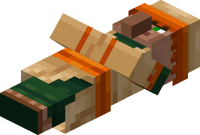
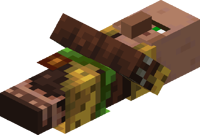


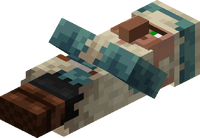
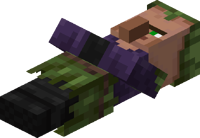

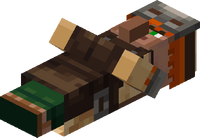


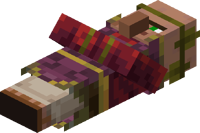
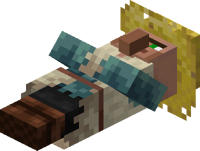
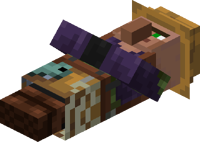




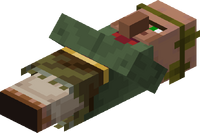

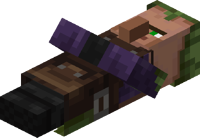


![An image released earlier by Jeb showing separated villagers.[6]](https://static.wikia.nocookie.net/minecraft_gamepedia/images/0/08/Jeb_release_21_May_12.png/revision/latest/scale-to-width-down/120?cb=20120522054801)






